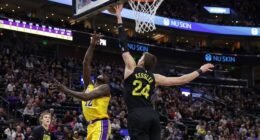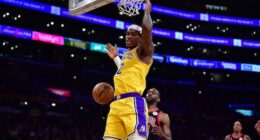21 victories, 61 defeats. This was the final tally of the 2014-2015 season for the Los Angeles Lakers, the worst in the franchise’s 67-year history.
As a lifelong Laker fan, I know that if a season results in the team falling short of a championship, there is always going to be a scapegoat and it’ll likely be unjustified. When the run at another three-peat and the ultimate farewell to Phil Jackson was trampled by the Dallas Mavericks in 2011, it was solely Pau Gasol’s fault for his lackluster performance.
In 2012, Steve Blake missed a potential game-winning three in Game 2 of the Western Conference Semifinals against the Oklahoma City Thunder after the team blew a seven-point lead in the final two minutes, leading to unnecessary and disgraceful threats from some fans via Twitter. The Lakers then squandered a late lead again in Game 4, leading to a 3-1 series deficit, shifting the blame to Mike Brown.
— Have you seen the ‘Bleed Purple and Gold’ phone case? —
Next up was Mike D’Antoni, who fans chastised from day one simply because the chants of “We want Phil” weren’t enough for the front office — including the late Dr. Jerry Buss — to overlook the severe obstacles that would have needed hurdling had Jackson been brought back. Not to mention the time for the Lakers to seek potential long term candidates for their head coaching position was long overdue.
Not hiring the 11-time coaching champion was a unanimous decision amongst Laker brass, yet one man has received an inordinate amount of culpability for it, along with just about everything else that has had a negative impact on the franchise in recent years. That man is Jim Buss — executive vice president of basketball operations and partial heir to the purple and gold throne passed down by his legendary father.

Despite Kobe Bryant’s desire for the team to trade Bynum, Buss and general manager Mitch Kupchak held their ground, electing to wait on the big man’s development. The decision helped Bryant rescind the trade demand of his own prior to the 2007-2008 season, which saw the Lakers jump out to a 26-11 start before losing Bynum to a season-ending injury and later acquiring Gasol. Bynum would of course be the team’s starting center for the back-to-back championships earned in 2009 and 2010 before being voted a Western Conference All-Star starter in 2012.
Laker fans watched Bynum develop into a fantastic young player, ready to take the next step in his career, seemingly overcoming his oft-injured knees, until they crept back into the picture. Heading into the final year of his contract, Bynum suffered from further knee issues along with displaying concerning levels of immaturity. The Lakers were then able to flip Bynum for Dwight Howard, who turned out to be a one-year rental, but that still proved to be a more beneficial route, considering the former is no longer in the league.
Had the Lakers decided to maintain their faith in Bynum, a five-year max contract would have been spent to keep him in purple and gold. If you think the past two seasons have been rough, imagine similar results with no cap space to spend due to Bynum mucking up the checkbook while sitting out the vast majority of games. Let it serve as a reminder that although the past few seasons have been difficult, they could have been far worse.

This of course, would all happen the year after the infamous trade that would have brought Chris Paul to the Lakers was nixed by the league, which sent Los Angeles reeling.
Either way, the summer of 2012 was going to dictate the coming years of the franchise, and they chose to make a deal for a player that many regarded as the best center in the league at the time. Howard left after a single season, but is that Buss’ fault? No. It’s nobody’s fault. Howard didn’t mesh with Bryant and the Lakers, so he made the decision to do what he felt was most comfortable and better suited for himself and his career.
With trades, sometimes you hit home runs and sometimes you strike out. Because of Nash’s health and Howard’s departure, the Lakers struck out. After a long list of transactions throughout their history that saw them become the beneficiary, a major deal gone sour was bound to happen. That shouldn’t overshadow all the good that has come with Buss at the helm.
He took over his position the year after one of the most dominant players in NBA history, Shaquille O’Neal, was traded away and the Lakers found themselves in the NBA Finals just three years later. With Buss and Kupchak partnering as vice president and general manager, Los Angeles has made deals to acquire Gasol, Trevor Ariza, Ron Artest (aka Metta World Peace), Paul, Nash and Howard. That’s quite an impressive list of players to acquire in a matter of only five years (2007-2012). You can’t really blame anyone in the front office for Nash and Howard not panning out or the Paul trade being vetoed. All of those names brought some form of exhilaration to Laker fans, whether it was short-lived or not.

Finally, the Lakers are building an entire core that can grow together over the next decade or so. It’s time to appreciate that, while possessing the patience that comes along with it.
But per usual, the credit and praise will likely be passed over Buss and given exclusively to Kupchak, just like when anything else goes right for the organization. When the opposite happens, the criticism will fall on Buss’ shoulders. It’s a narrative that makes no sense at all, yet has carried on for years, even though Kupchak openly admitted earlier this year that he should receive his fair share of the blame. “Any decision that’s happened in the past two or three years that people have a problem with, I was involved or leading the way,” Kupchak said. “So, if there’s criticism then it should be directed at me as well. He (Buss) is not making decisions in a vacuum.”
I’m not saying it’s simply Kupchak’s fault when something goes wrong, either. It’s a collective effort in the front office, just like it is on the court.
Us Laker fans have been spoiled throughout the years. Every generation of the fan base has witnessed the franchise win an NBA championship, if not several. Yes, the team has hovered around the bottom of the league for two years, but that’s nothing when you consider the fact that some franchises have gone decades without giving their fans a winning product.
And I’ve got news for you — every professional sports franchise goes through rebuilding periods. The New York Yankees, the Lakers, you name it. It’s no particular individual’s fault when a competitive window closes, forcing the rebuilding process. It’s simply the nature of the beast and part of the cycle.
The roster needed to be rebuilt back in 2005 when Buss began his current role, and it was accomplished, resulting in three NBA Finals appearances and back-to-back titles. Him and Kupchak have found solutions in the past, and they’ll do so again.
[divide]






